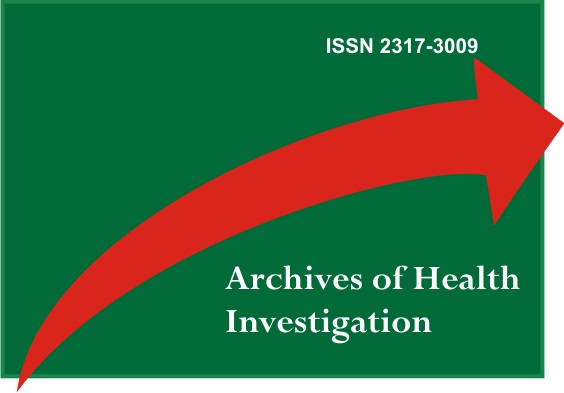Fratura de mandíbula tratada através da técnica de Champy: relato de caso
DOI:
https://doi.org/10.21270/archi.v10i3.5082Palavras-chave:
Mandíbula, Traumatismos Mandibulares, Fixação Interna de FraturasResumo
Os traumas faciais representam um dos mais importantes problemas de saúde pública. As fraturas mandibulares compõem grande parte das injúrias sofridas pelo complexo maxilomandibular neste panorama. A região mais acometida é o ângulo mandibular (AM), devido a sua área de seccção transversal e biomecânica, além da presença de terceiros molares. Este artigo visa relatar um caso clínico de fratura mandibular, evidenciando diagnóstico e terapêutica. O relato de caso trata-se de um paciente do gênero masculino, 19 anos de idade, que compareceu ao ambulatório do serviço de Cirurgia Bucomaxilofacial de um hospital público queixando-se de dor à mastigação e dificuldade de abertura bucal. Ao exame radiográfico foi identificada solução de continuidade na região de ângulo mandibular, confirmando a hipótese diagnóstica de fratura de mandíbula. O tratamento proposto foi de procedimento cirúrgico sob anestesia geral para osteossíntese através do método retratado por Champy, utilizando-se de acesso intrabucal na região da linha oblíqua externa e bloqueio maxilo-mandibular (BMM) transoperatório com parafusos, seguida a fixação com a utilização de uma placa do sistema 2.0mm e posterior remoção do BMM. O paciente foi acompanhado durante seis meses e mostrou resultado clínico satisfatório. Conclui-se que a técnica de Champy é um método eficaz de fixação interna de fraturas, pois reduz o tempo cirúrgico e a dissecção tecidual, diminuindo as chances de lesões nervosas e complicações pós-operatórias.
Downloads
Referências
Brasileiro BF, Passeri LA. Epidemiological analysis of maxillofacial fractures in Brazil : A 5-year prospective study. Oral Surg Oral Med Oral Pathol Oral Radiol Endod. 2004;102(1) :28-34.
Kim M, Kim C, Han S, Lee JA. A comparison of three treatment methods for fractures of the mandibular angle. Int J Oral Maxillofac Surg; 2016;45(7):878-83.
Morris C, Bebeau NP, Brockhoff H, Tandon R, Tiwana P. Mandibular Fractures: An Analysis of the Epidemiology and Patterns of injury in 4143 Fractures. J Oral Maxillofac Surg. 2015;73(5):95.
Hasegawa T, Sadakane H, Kobayashi M, Tachibana A, Oko T, Ishida Y et al. A multi-centre retrospective study of mandibular fractures: do occlusal support and the mandibular third molar affect mandibular angle and condylar fractures?. Int J Oral Maxillofac Surg. 2016; 45(9):1095-1099.
Saito DM, Murr AH. Internal fixation of mandibular angle fractures with the Champy technique. Oper Tech Otolayngol Head Neck Surg. 2008;19(2):123-27.
Sugar AW, Gibbons AJ, Patton DW, Silvester KC, Hodder SC, Gray M et al. A randomised controlled trial comparing fixation of mandibular angle fractures with a single miniplate placed either transbuccally and intra-orally, or intra-orally alone. Int J Oral Maxillofac Surg. 2009;38(3):241-45
Ellis E 3rd. Treatment methods for fractures of the mandibular angle. Int J Oral Maxillofac Surg. 1999;28(4):243-52.
Al-Moraissi EA, Ellis E. What method for management of unilateral mandibular angle fractures has the lowest rate of postoperative complications? A systematic review and meta-analysis. J Oral Maxillofac Surg. 2014;72(11): 2197-211.
Paza AO, Abuabara A, Passeri LA. Analysis of 115 Mandibular Angle. J Oral Maxillofac Surg. 2008; 66(1):73–6.
Braasch DC, Abubaker AO. Management of mandibular angle fracture. Oral Maxillofac Surg Clin North Am. 2013;25(4):591-600.
Michelet FX, Deymes J, Dessus B. Osteosynthesis with miniaturized screwed plates in maxillo-facial surgery. J Maxillofac Surg. 1973;1(2):79-84.
Champy M, Loddé JP, Schmitt R, Jaeger JH, Muster D. Mandibular osteosynthesis by miniature screwed plates via a buccal approach. J Maxillofac Surg. 1978;6(1):14-21
Laverick S, Siddappa P, Wong H, Patel P, Jones DC. Intraoral external oblique ridge compared with transbuccal lateral cortical plate fixation for the treatment of fractures of the mandibular angle : prospective randomised trial. Br J Oral Maxillofac Surg. 2012;50(4):344–9.
Seemann R, Schicho K, Wutzl A, Koinig G, Poeschl WP, Krennmair G, et al. Complication rates in the operative treatment of mandibular angle fractures: a 10-year retrospective. J Oral Maxillofac Surg. 2010;68(3):647-50.
Ma'aita J, Alwrikat A. Is the mandibular third molar a risk factor for mandibular angle fracture? Oral Surg Oral Med Oral Pathol Oral Radiol Endod. 2000;89(2):143-6.
Choi BH, Kim KN, Kang HS. Clinical and in vitro evaluation of mandibular angle fracture fixation with the two-miniplate system. Oral Surg Oral Med Oral Pathol Oral Radiol Endod. 1995;79(6):692-95
Ellis E, Walker L. Treatment of mandibular angle fractures using two noncompression miniplates. J Oral Maxillofac Surg. 1994;52(10):1032-36.
Kuriakose MA, Fardy M, Sirikumara M, Patton DW, Sugar AW. A comparative review of 266 mandibular fractures with internal fixation using rigid (AO/ASIF) plates or mini-plates. Br J Oral Maxillofac Surg. 1996;34(4):315-21.
Valentino J, Marentette LJ. Supplemental maxillomandibular fixation with miniplate osteosynthesis. J Otolaryngol Head Neck Surgy. 1995;112(2):215-20.


